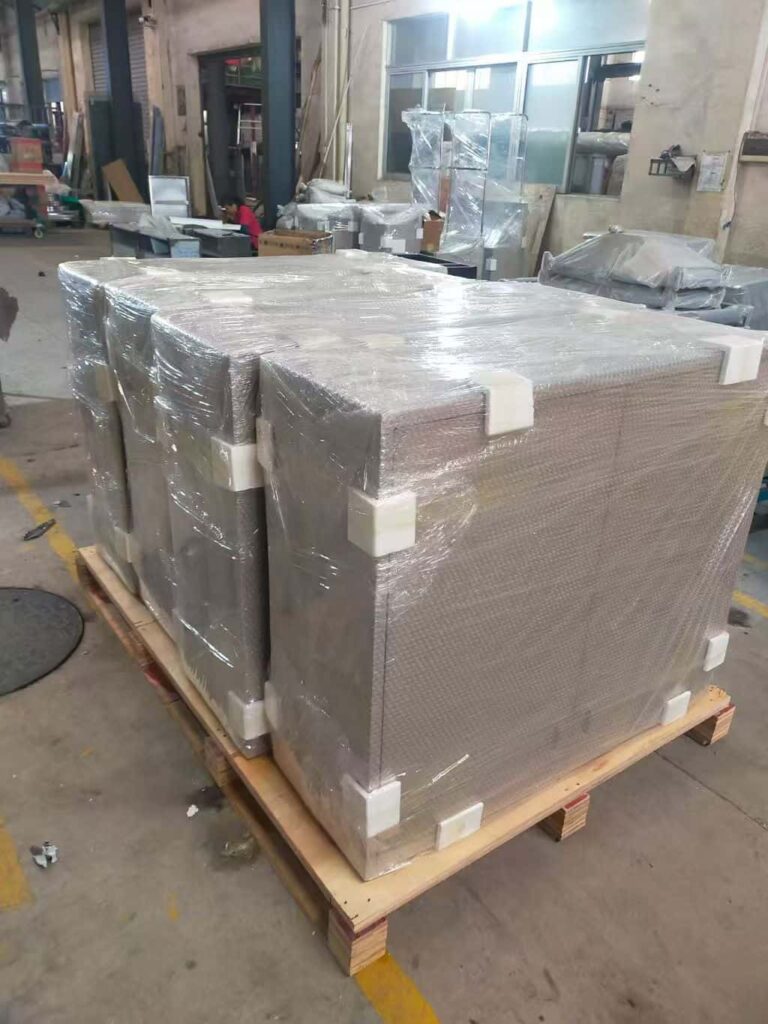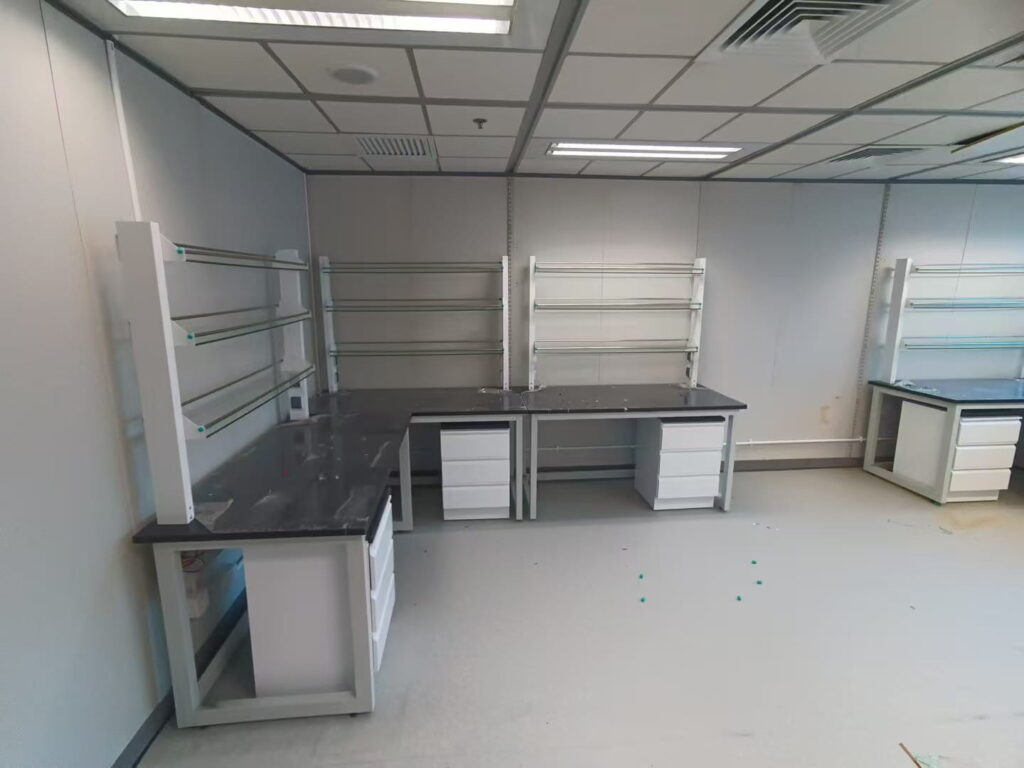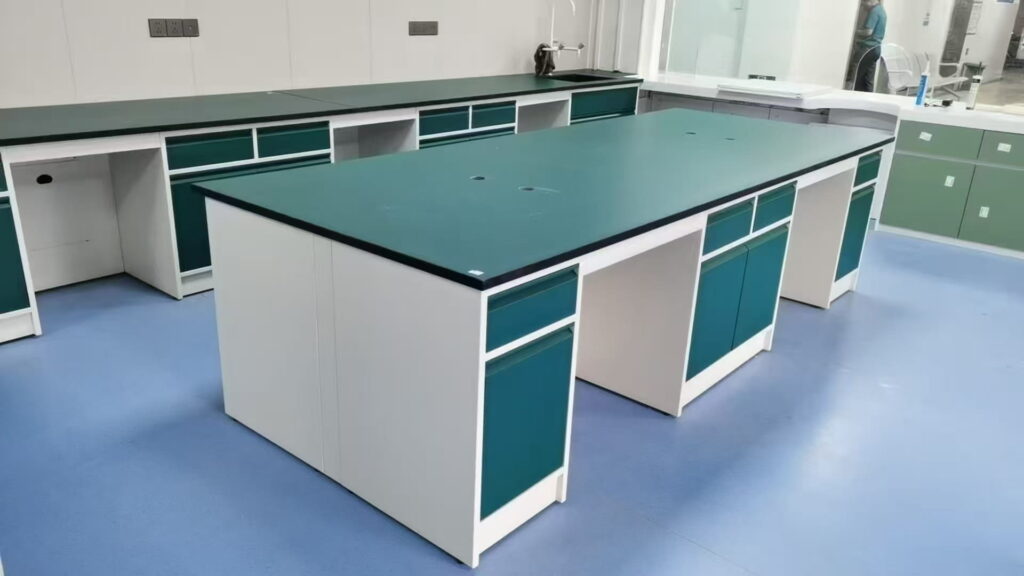In labs, cleanrooms, and high-end manufacturing, hygiene, durability, and corrosion resistance are critical. The stainless steel lab bench is the undisputed standard here. Yet, many ask: Is stainless steel truly suitable for workbenches? The answer is clear. In specific, demanding settings, the stainless steel lab bench isn’t just suitable. It is the optimal, often irreplaceable, solution.
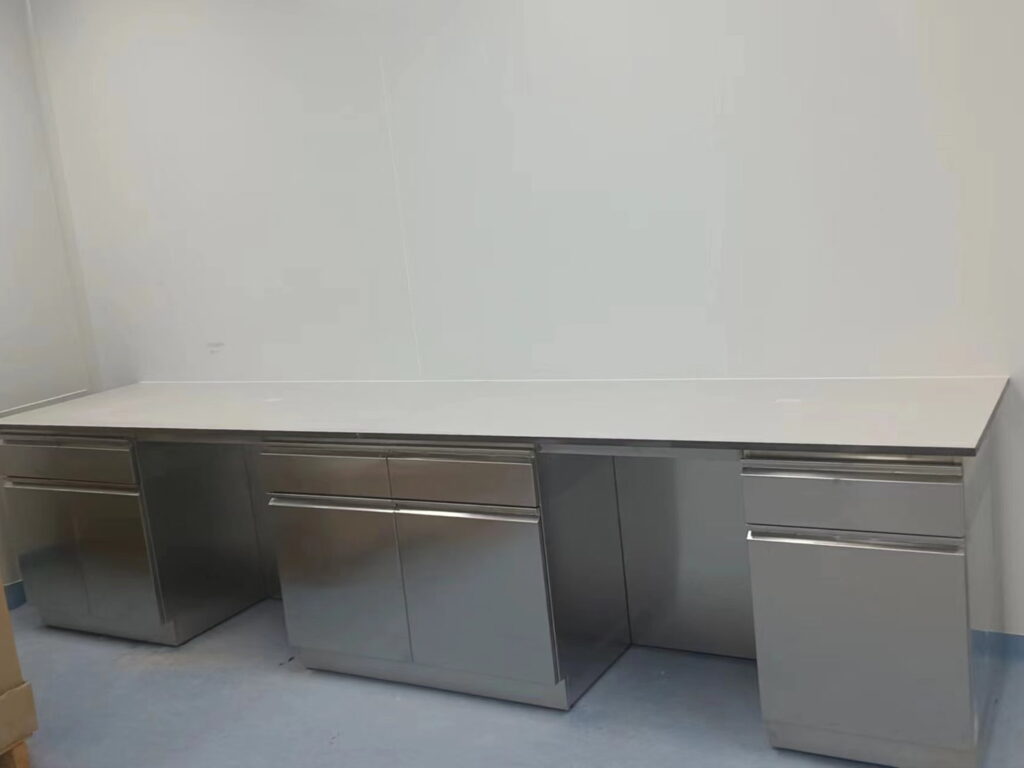
1. Why Choose Stainless Steel? Key Advantages
Unmatched Corrosion Resistance (Core Strength)
- This is the foundation of the stainless steel lab bench.
- It resists everyday spills, cleaners, lab acids, alkalis, solvents, oils, and chemicals.
- High-quality grades (304, 316L) offer superb protection.
- Ordinary steel benches rust easily in damp or corrosive settings.
- Rust contaminates samples and shortens lifespan.
- A quality stainless steel lab bench stays pristine for years.
- It’s ideal for chemistry labs, biology labs, pharma production, plating, and washdown areas.
Superior Hygiene & Easy Cleaning (Essential)
- The surface is dense, smooth, non-porous, and seamless (with good welding).
- This stops bacteria, mold, and grime from growing or penetrating.
- Wood, laminate, and plastic can’t match this.
- Cleaning is simple. Use water, alcohol, or disinfectant. Wipe clean.
- This meets strict standards: GMP, HACCP, ISO 14644.
- These standards govern cleanrooms, sterile areas, food processing, and biolabs.
- An easy-to-clean stainless steel lab bench protects product quality and personnel safety.
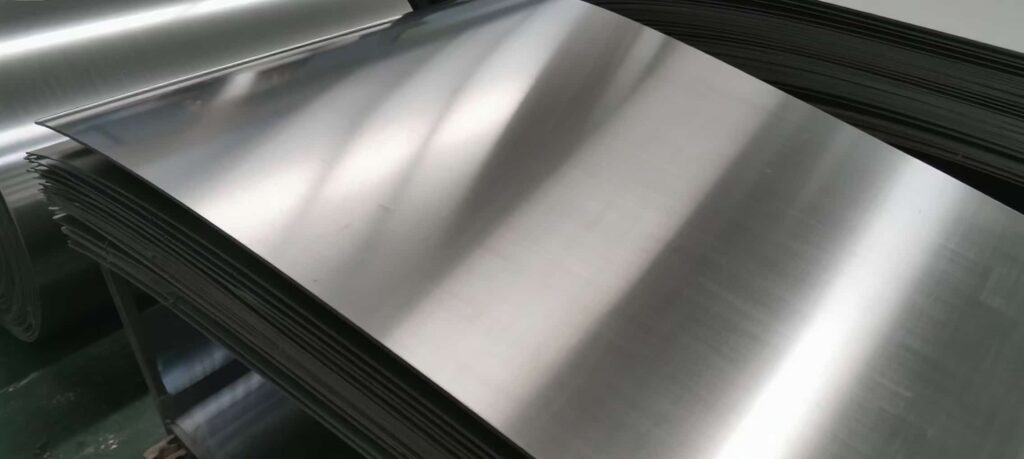
Exceptional Strength & Durability (Long-Term Value)
- Stainless steel has very high mechanical strength.
- It offers excellent wear and impact resistance.
- Heavy equipment, tool drops, or scrapes rarely cause damage.
- Lifespan far exceeds other materials.
- A well-made stainless steel lab bench lasts decades.
- This significantly cuts long-term replacement costs. Buy once, use forever.
- Wood warps, dents, and swells with water.
- Painted steel benches chip and rust.
High Heat & Fire Resistance (Safety)
- Stainless steel has a high melting point (over 1500°C).
- It does not burn.
- It resists deformation and toxic fumes under fire.
- This adds safety near ovens, hot items, or welding zones in labs.
- Note: Extreme, constant heat might cause discoloration. But structure stays safe.
Modern Look & Eco-Friendly (Added Benefits)
- The stainless steel lab bench looks clean, sleek, and professional.
- It boosts the image of labs, workshops, and cleanrooms.
- Stainless steel is 100% recyclable.
- It supports sustainable, eco-friendly practices.
2. Potential Limitations & Solutions
No material is perfect. Consider these points for stainless steel lab bench.
Higher Initial Cost (Main Hurdle)
- Fact: Material and making costs are higher than wood or steel-wood lab bench.
- Solution: See it as a long-term investment.
- Calculate its decades-long life and low upkeep costs.
- Factor in reduced downtime and contamination risks.
- Its Total Cost of Ownership (TCO) is often better.
- On a tight budget? Use stainless steel lab bench only in core areas.
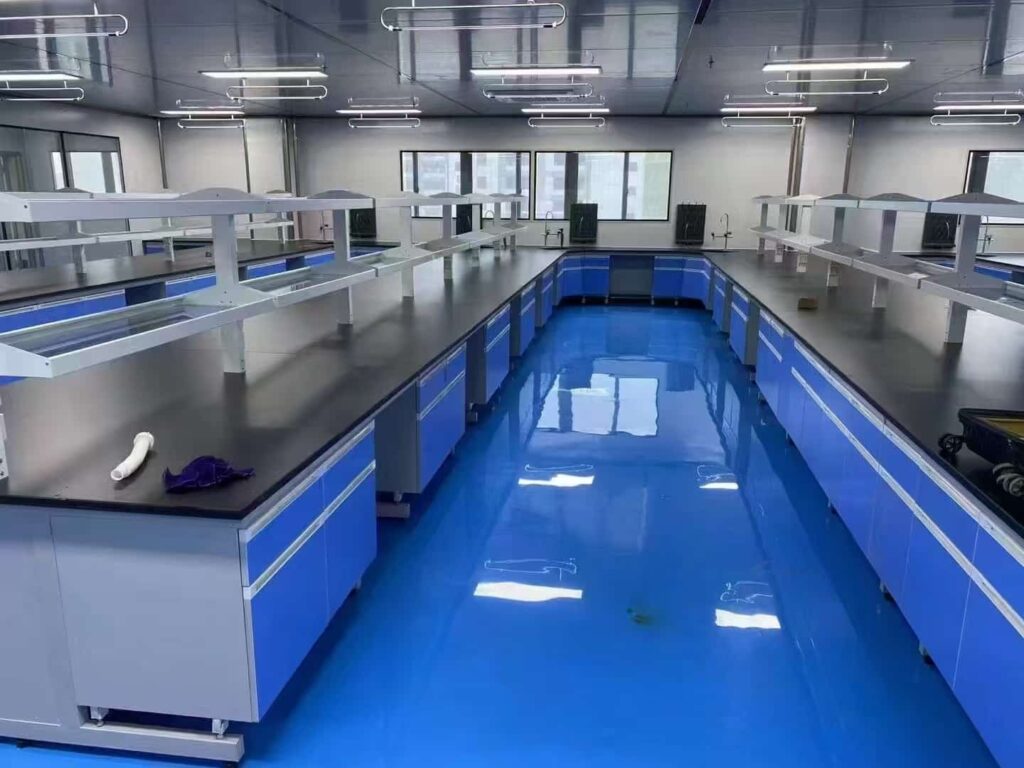
Surface Scratches (Aesthetics)
- Fact: Dragging sharp tools can scratch the surface, despite its hardness.
- Solution: Choose a brushed (satin) finish.
- Brushed finishes hide scratches better than mirror polish. They are practical.
- Use protective mats or boards in busy work zones.
- Remember: Functional scratches rarely hurt corrosion resistance or hygiene.
Good Heat Conduction (Be Aware)
- Fact: Heat moves fast through metal.
- Hot objects quickly heat the contact point.
- The surface feels cold in chilly places.
- Solution: Always use trivets or stands for hot items.
- Consider mats for comfort in cold spots.
- Note: Fast heat transfer is good when you need quick cooling.
Heavy Weight & Noise
- Fact: Density makes stainless steel lab bench heavy. Hard to move.
- Dropped items make loud noises on metal.
- Solution: Plan for fixed locations.
- Need to move? Choose benches with heavy-duty lockable casters.
- Use anti-vibration pads or rubber mats in noise-sensitive areas.
Electrical Conductivity (Caution Needed)
- Fact: Metal conducts electricity. This risks static damage to sensitive electronics.
- Solution: In electronics labs or repair areas using a stainless steel lab bench, you MUST add certified ESD mats.
- Ground the mats properly. This safely drains static charge.
- Consider ESD-protected stainless steel lab bench solutions.
3. Where Stainless Steel Lab Bench Excel
In these fields, the stainless steel lab bench is essential. It’s the top choice.
Life Sciences Labs
- Biology Labs: Need sterile work, cell culture, microbe studies. Demand absolute cleanliness. Easy sterilization. The stainless steel lab bench is standard.
- Pharma R&D & Making: Must follow GMP rules. Zero contamination risk. Used throughout the process.
- Medical Testing: Handles samples and reagents. Needs to withstand frequent disinfectant wiping.
Pathology Labs
- Exposed to acids, alkalis, solvents, salts.
- A corrosion-resistant stainless steel lab bench (especially 316L) is vital. It ensures safety and long life.
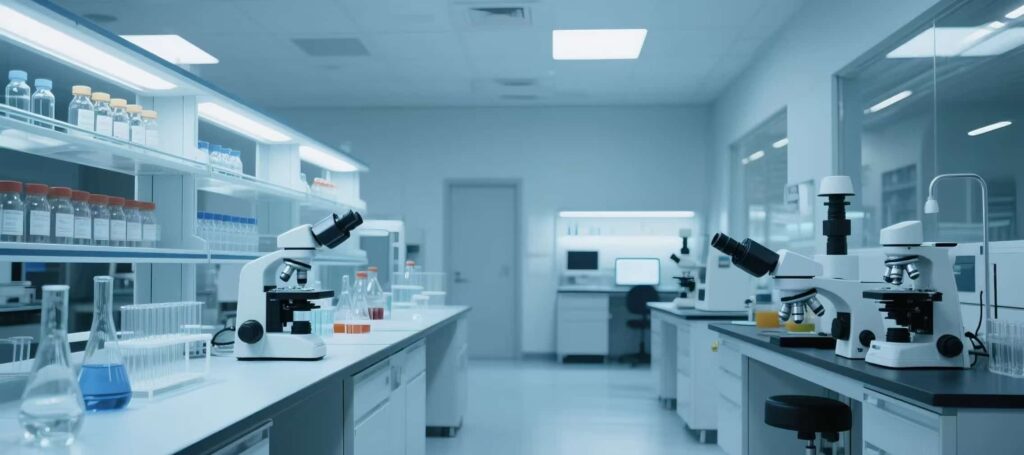
Food, Beverage Making & Testing
- Production floors, central kitchens, QA labs.
- HACCP-level hygiene is required. Frequent washing and disinfection happen.
- The stainless steel lab bench is key food safety infrastructure.
High-End Making & Electronics (With ESD)
- Semiconductor, optics, precision instrument assembly.
- With proper ESD measures, the cleanliness and stability of stainless steel lab bench are crucial.
Cleanrooms & Sterile Areas
- ISO-level cleanrooms, surgical support zones.
- Must be dust-free, non-shedding, easy to sterilize. Non-negotiable.
Harsh Industrial Settings
- Chemical plants, plating, water treatment, marine labs or QC.
- Faces severe corrosion. The stainless steel lab bench stands strong.
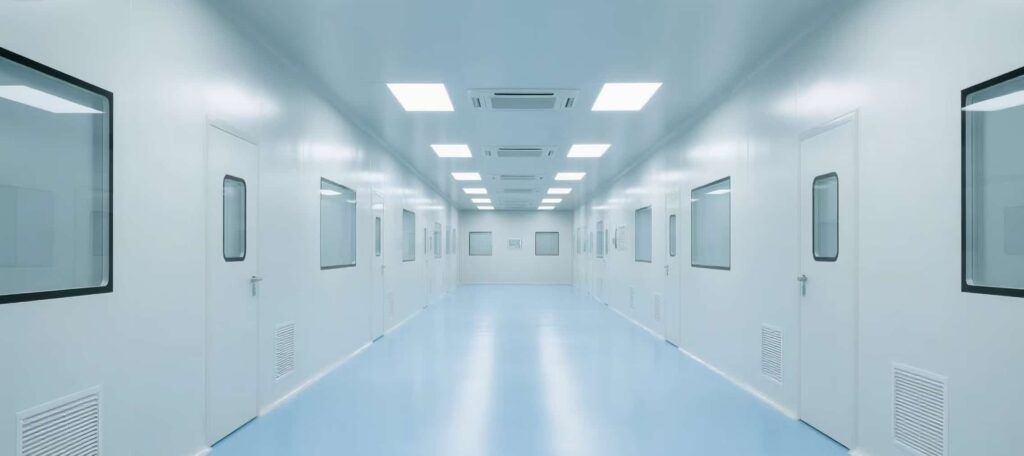
4. Buying Guide: Key Choices
How to choose between 304 and 316 stainless steel
- 304 Stainless: General use. Cost-effective. Good for most labs, food, general industry. Meets most needs.
- 316L Stainless: Has molybdenum. Much better chloride resistance (salt water, bleach). Better against pitting. Strongly recommended for coastal areas, chemical plant labs, medical zones, high-salt/strong acid-base use. Costs more.
Work Surface Thickness
- Standard Load: 1.0mm – 1.2mm (needs strong support underneath).
- Heavy Load/Max Durability: 1.5mm or thicker. Thickness fights bending and dents. Adds rigidity.
Surface Finish
- Brushed (Satin): Most Recommended! Looks good. Practical. Scratch/scuff resistant. Low glare. Industry standard.
- Matte: More scratch-resistant. Softer look.
- Mirror Polish: Highest shine for display/ultra-clean spots. Scratches very easily. Needs special care. Use carefully in busy lab areas.
Structure Design
- Strong Frame: Use square steel tube or industrial aluminum. Welds must be strong, smooth, solid.
- Support Underneath: Must have a robust base (moisture-proof board, phenolic core, honeycomb). Prevents sagging under weight.
- Seamless Corners: Corners need large curves or expert welding/polishing. Creates true seams. Stops dirt traps. This shows good stainless steel lab bench craft.
- Fits Accessories: Needs pre-drilled holes for Laboratory sinks, faucets, racks, power outlets.
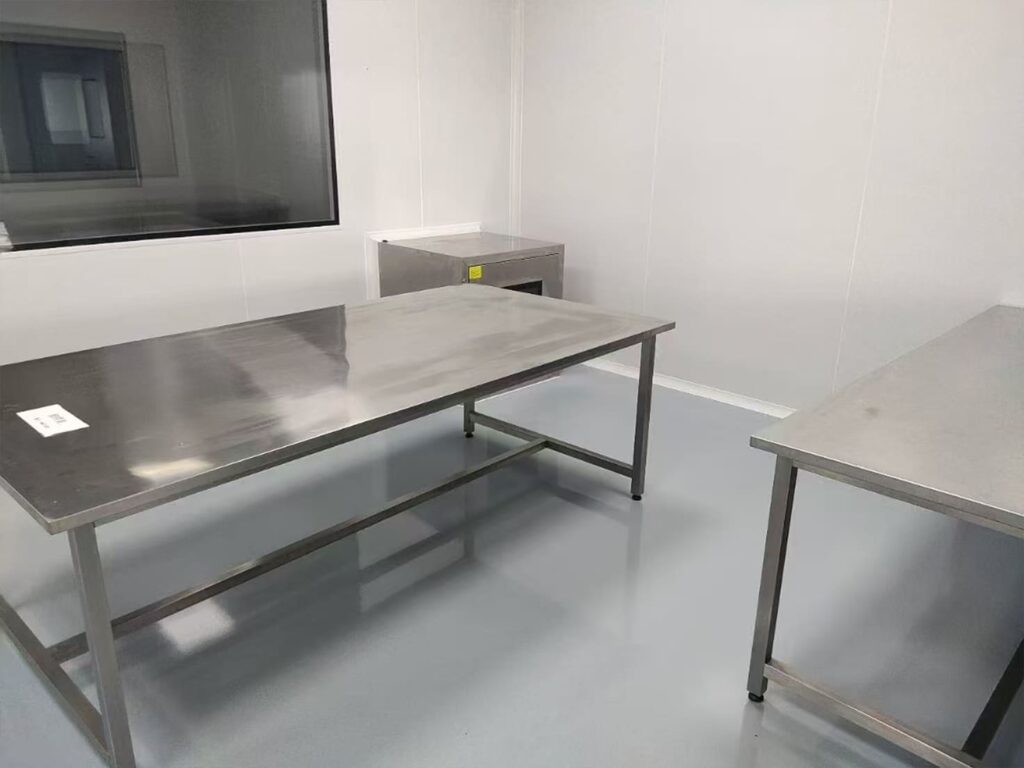
Choose a Good Maker
- Choose an experienced and trustworthy laboratory furniture supplier who understands laboratories and industry standards.
- Check weld quality, edge finishing, material proof (mill reports), past projects.
5. Stainless Steel Lab Bench vs. Others
| Feature | Stainless Steel Lab Bench | Epoxy Resin Top | Solid Phenolic Top | Steel-Wood benches | PP Plastic Bench |
|---|---|---|---|---|---|
| Best At | Corrosion King, Hygiene, Durability, Fireproof | Extreme Chemical & Heat Res., Seamless | Very Good Chemical & Heat Res. | Good Load, Mid-Cost | Light, Chemical Res., Moldable |
| Weakness | Higher Cost, Scratches (Deep), Heavy | Higher Cost, Impact/Scratch Sensitive | Weak Seams, Hates Moisture | Steel Rusts, Has Seams | Weak, Can Warp/Age |
| Best For | Bio/Chem/Pharma, Food, Cleanrooms, Harsh Industry | Severe Chemical Labs | General Chem Labs | Budget Labs/Workshops | Light Wet/Corrosion, Temp Sites |
| Hygiene/Sterile | ⭐⭐⭐⭐⭐ | ⭐⭐⭐⭐ | ⭐⭐⭐ | ⭐⭐ | ⭐⭐⭐⭐ |
| Long Life | ⭐⭐⭐⭐⭐ | ⭐⭐⭐⭐ | ⭐⭐⭐⭐ | ⭐⭐⭐ | ⭐⭐ |
| Start Cost | High | Very High | Medium-High | Medium | Low – Medium |
| Long-Term Cost | Very Low | Low | Medium | Medium – High | Medium – High |
Conclusion: The Professional Choice
So, is stainless steel suitable for workbenches? Absolutely. Clearly.
- In demanding professional settings needing top corrosion resistance, hygiene, long life, strength, and fire safety – especially labs, cleanrooms, food/pharma, advanced making, harsh industry – the stainless steel lab bench isn’t just “suitable”. It’s the gold standard. The best solution. Its performance meets tough needs. Its long-term value beats the initial cost.
- Yes, upfront cost is higher. Avoid deep scratches. But its unbeatable life, easy care, and near-zero long-term failures make its Total Cost of Ownership (TCO) highly competitive professionally.
Therefore: If your work involves chemicals, bio agents, food making, sterile work, frequent cleaning/disinfection, or long-term damp/corrosive conditions? Investing in a high-quality stainless steel lab bench is the smartest move. It ensures safety, boosts efficiency, meets rules, and saves money long-term. Choosing a well-made, reliable (like 304 or 316L), smartly designed stainless steel lab bench builds a solid, clean, lasting shield for your critical work.

